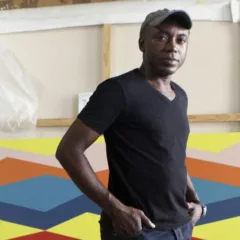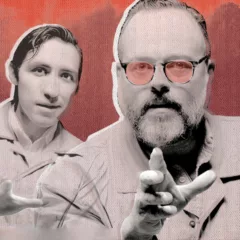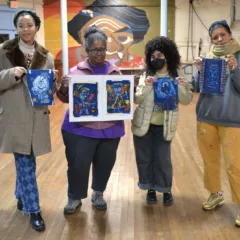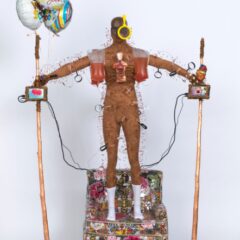Episode 272 – In this conversation, Roberta and Ryan discuss Ken Lum’s solo exhibition at Ulises, a Bach Cello Suites project by Megan Bridge and her son at the Philadelphia Museum of Art, and the No Arena Drag Show supporting Chinatown. We discuss BlackStar winner Crystal Sotomayor and highlight events and openings this coming week. We also delve into a 2023 report on museum employees and diversity. I hope you enjoy it. ~Ryan
Audio Player
Click to expand the podcast transcript
Roberta: Hi everyone, it’s Roberta.
Ryan: And this is Ryan and this is the Midweek News
Roberta: On Artblog Radio. Welcome everyone. And hi Ryan. You are sitting with a beautiful view of a lake in back of you (I can see this on our Zoom call). Where are you this morning?
Ryan: I’m outside of Black Lake, outside of Lake Michigan in Holland, Michigan.
Roberta: Black Lake. Wow. Is it black? No. Looks kind of blue behind you. Pretty behind you.
Ryan: It’s pretty, pretty idyllic. Like it’s a pretty great co-working space. Just sitting on a picnic bench with some seagulls. Getting away from seagulls. There’s no sea seagulls. Yeah. No complaints from me right now. Perfect Temperature, not too much wind. Beautiful Sunny day.
Roberta: All right. Well, you just keep on…
Ryan: I could keep rubbing it in.
Roberta: Yes. Yeah, no, don’t do that. Oh, well we all are here and I bet it’s not in the eighties today. It’s probably going to be in the seventies where you are.
Ryan: I think we just cracked 70 a little bit ago. Yeah, not much more than that today. Good. Excellent.
Roberta: Well, yeah. Let, let’s do, let’s talk about news while we’re done with the weather report and being envious of where you are and what you are doing and your companions, the seagulls. I have three things I want to tell people about for the news. Three newsworthy things and it’s always going to be idiosyncratic here with me as you know, but it’s my passion coming across here and I think that’s fair.
So first I want to say Ken Lum is an all time wonderful artist and the head of the fine arts department at Penn and has been interviewed several times on Artblog. We love his art. He has a solo exhibition opening at Ulises on August 30th, Friday, August 30th. Ulises is now in Ray, the multi-use live/ workspace, on North American Street up from Crane Arts. Anyway, the exhibition is called Klump!, K-L-U-M-P-!, which I think is very much fun. And we’ll put links to the podcast that we did with Ken. Into the transcript, so you’ll be able to chase those down if you’re interested in his very conceptual and political, in his art. So, and wordy. There should be words and pictures and politics in what you’ll see. So it sounds like a really good, good exhibit. I’m happy that it’s coming up. He doesn’t get shown a lot in Philadelphia which is an oversight.
Ken Lum talks about the relevance of everything in 2019.
Ken Lum with Karyn Olivier podcast about Art and Social Responsibility in 2020
Ken Lum with Amy Sadao, Pepon Osorio and Aaron Levy on Artists and Social Responsibility in 2015
Ken Lum talks about monuments and Philadelphia in 2014 (he later co-founds Monument Lab)
Second is a notable event. There’s a Bach Cello Suites project that Megan Bridge, who is a dancer and a dance educator at Temple University and her son Tristan, who’s a teenage boy who plays the cello. They’re going to be performing together at the Philly Museum of Art on Friday August 16th and Saturday, August 17th, and we’ll put all the details about that (see PMA website for details. Megan, just to clue you in, is going to start writing for Artblog. She is former Director of ThINKingDance, and also a writer for that online publication that you may or may not be aware of. And she writing a history of experimental dance in Philadelphia, which we’re going to proudly debut at some in the near future, so stay tuned for that. The performance, by the way, is free with museum admission, so I think Friday is pay what you wish, 6:30 PM performance. So that would be the time to go. Apart from that, on Saturday, I do believe it’s full fee, but the dance performance is not a separate charge.
Last event I want to talk about is called No Arena Drag Show. And this is on August 24th, 5 to 8:00 PM at the Folk Art Cultural Treasures Charter School on Callowhill Street and 10th. In solidarity with No Arena in Chinatown , Let’s talk about Chinatown and Philadelphia Asian and Queer. Now I know about this because a friend who is also a Velocity fund awardee has a project called Let’s Talk About Chinatown. And I interviewed her, that is, Yvonne Lung, and Yvonne is a great social practice artist who really believes in art for people, art with people. And she’s doing this talking about Chinatown, all over the place, including at the drag show on the 24th to tell people what the value is of Chinatown and why they should care about this arena that’s coming in that is endangering Chinatown.
So it’s a really good project. There’ll be a piece coming up in Artblog pretty soon about my interview with Yvonne. You can listen to an older podcast interview I did with Yvonne and Dave Kyu about their Velocity awarded project, “Dish, The Meal Kit.” That’s about all I have right now, Ryan, but I think that’s quite a lot for actually the end of summer, which tends to be a wind down wrap down. Yeah. And waiting for the fall to happen. So, things are just still percolating all over the place.
Ryan: There’s a lot of things happening right now.
Roberta: Yeah. So what do you have for us today, Ryan?
Ryan: Well, in the news section, I wanted to add that, Kristal Sotomayor won the Black Star Film Festival’s Philadelphia Filmmaker Award. So that’s pretty great. So we need to get her on this podcast sometime.
Roberta: And I think she has been, I think well yes. Get her on our new news podcast. Yeah, that’d be great. But there is a podcast, Wit Lopez did a podcast with her in 2019.
Ryan: She did the documentaries about ICE and Philadelphia no longer working with I.C.E. So that’s pretty, a powerful change that the city made.
A couple events I wanted to point out. Coming up on the 17th of August, the first annual Urban Art Fest, 52, it’s going to be on 52nd Street between Walnut and Spruce, is going to be put on by Urban Art Gallery, and that could be a lot of fun. It’s going to be a block party on 52nd Street from 12 to 7pm, free admission, some vendors, music, arts gallerists. Looks like a lot of fun.
Roberta: That sounds wonderful.
Ryan: So a lot still happening in August. School starts obviously in a couple weeks, but things are still humming along. And then I always give my theater shout out. So last week I talked about the Philadelphia Women’s Theater Festival, and I just want to pull one out from that — “Pancake Queen.” That is a story about a retelling of Aunt Jemima’s story.
Roberta: Oh wow.
Ryan: And I think, I think that would be a really powerful show to see. All those shows are going to be at Theater Exile. Take a look at those theater tickets are available. Through Theater Exile, Philadelphia Women’s Theater Festival. Find those there. A lot of good theater happening right now. Surprisingly, as you said, it’s, it’s August, it’s in the summer, and yet there’s a lot of great things happening. Check out ArtblogConnect‘s calendar to see what’s happening to stay up on, on different things that are, that are happening throughout the town.
Roberta: I want to say, if I can just interject another book here. Speaking of a retelling of a mythic character, there’s a book called James by Percival… I’m blanking on his last name, Percival Henry? perhaps I’ll look it up. It’s, it’s about, it’s a retelling of the story of Jim in Huckleberry Finn.
Ryan: Everett.
Roberta: Everett. Thank you. It’s really good. It’s so powerful, those retellings of stories from the black perspective. They just blow you away. They’re really good. So, bravo.
Ryan: And then lastly for me, I, last week I had mentioned that there’s some numbers that I wanted to talk about and so I was looking at a, a report that I thought was really interesting that I wanted to share some information from, and we’ll put the whole report in the show notes so you can look along with it and listen back to what we’re looking at. But this is brought to you by Museums Moving Forward. It’s a 2023 report talking about museum employees and cultural diversity in the workplace. And their survey respondents, or it came in around 2000. There were 54 museums. That they reached out to, to respond to this. Only one from Philadelphia. ICA Philadelphia was one of the respondents.
Roberta: ICA. All right. So not the PMA and not PAFA and not Lasalle. Was LaSalle University in there.
Ryan: No, I was surprised.
Roberta: St. Joe’s University has a museum.
Ryan: Yeah. I’m surprised there weren’t more respondents. I’d be curious. I’m sure there’s a lot of reasons that I’m unaware of, obviously, but I would love to hear more from their, their thoughts and opinions. But a couple of the key takeaways that they list early on talked about there is growing diversity, but there’s still a lack of diversity throughout which is not terribly summarizing.
I think really the biggest takeaway for me was that 60% of art museum workers are thinking about leaving their job. 68% are cons considering leaving the field altogether. And and the, the, the biggest reason why 82% said that they believe in the work that they’re doing is meaningful work. So it’s work they do believe in. The problem came down to what I presume to be pay, and 74% of workers cannot afford their basic living expenses from the museum compensation loan. So you’re working at a museum and then you have a side hustle that’s a lot. Or you need a second income from. A partner in your life that, that’s a lot to ask, and that included 29% of executives, which was surprising.
Roberta: Well, what do you consider an executive, a curator, an assistant curator? Those don’t make a lot of money. Are they executives though?
Ryan: Yeah, I think it’s once you reach that managerial level. Of the department, department heads and beyond, I think is where they were classifying that. It was interesting. There’s a lot of really interesting breakdown. They, they break down gender self-reported through, through the survey. 74 per 71% of response were women. 64% are white, so.
Roberta: So this is, this is self-reporting. Anonymous. Probably it’s, they didn’t have to put their names in there, but they, yeah. Terrible. They needed to put, yeah. Really they needed to say what their job was so that they could figure out the levels of experience and levels of disgruntlement, et cetera. Yeah. Did there seem to be an agenda behind this? Like the, the organization, is it known as pushing for better pay in museums or are they sort of a e data wonks? You know, they just, like, this one was to gather data.
Ryan: Sure. This one was specifically talking about equity. They’re, they’re endeavoring in this part to, I think, identify gaps in, in that. And I think tenure was one of those things. So like. If you were looking at the tenure numbers that they were offering, if you were white and male you have the most likelihood of long tenure, which shocks no one. So for sure. But yeah, but I think it’s, I think it’s along those kind of things. We’re we, as much as we try, we still give into biases and preconceived stereotypes and things of those natures. Just kind of generally as a, as part of our culture, and we need to continue, continue to do more work to, to open up who, who works where, and why.
And for how long and who gets promoted level promotion, likelihood of promotion comes in something on the level, like, I can’t remember where I put that note, but something on the level of 13 years between promotions in museums. You may not have a lot of upward mobility, but that seems like a long time to stay in a position to then wait for promotion.
Roberta: That would be because they’re not unionized. I mean, yeah. If you were unionized, you would put those sort of. You know promotion benchmarks in there, you would build that in and you would negotiate it and you’d get pushback from the institution, of course. It could be a make or break issue.
And it says to me that museums are just not unionized. And in fact, it would be good to know if any of the museums that they surveyed had unions in them.
Ryan: Yeah, I’m not sure they said that, but I know they were saying that 84% of the respondents at least, were non-unionized. I’m not sure if they were broke down. It was, if there was a breakdown between job positions. And type of work. But yeah. So we’ll have a link to this document. It’s 137 page report. It’s really interesting, a lot of takeaways from it. But yeah, pay and equity. Same conversation, different day. So hope, you know, it’s maybe getting better, but it’s, it’s still still worth having a conversation.
Next week I want to talk about some of the, the foundational fundings for galleries and art and art museums after the pandemic and how artists pay is still down by a quarter from five years ago. So we’ll talk about that next week.
Roberta: So artists pay at organizations other than museums kind of thing?
Ryan: Yeah. Through galleries, through museums, through foundations, through grant funding. Because so many of those shuttered or they lost their funding, or a lot of, lot of those things
Roberta: We’re still not out of it. You know, the pandemic and the recession really did a number on everybody and Yeah, it’s, you know, restaurants, they’re in the same boat and theaters, oh my gosh.
You know, there’s. It’s difficult. Opera Philadelphia had a really very hard decision to make and they didn’t go forward with their festival this year. Their o festival, which they have had and was, you know, nationally renowned as being a great thing. So we’re, I don’t know where we get the money. And I think we were talking about this earlier when you knock on the door.
The person opens and you, you know, are asking for something and whoever opens the door has an ideological mindset. And it may be a lot different than yours. And so you have two forces coming together that are almost irreconcilable When it comes to that. And I don’t know how you’d change that.
It’s gotta be a, a complete societal overhaul, I think, which Sure. Is for another discussion entirely. Yeah. Anyway, I want to mention a book because I do this, and we have a book here that one of our former writers, Natalie Sandstrom wrote a chapter in her chapters called Creating a More Equitable Experience for Museum Interns.
So this book too, is about equity. Has lots of chapters. It’s an edited volume with essays by, I don’t know, it looks like 50 people. But it’s called for love or money, and that’s really what it boils down to. Right? You love your job. It Yeah. But you need the money and so it’s, there’s real disequilibrium there.
Yeah. And we’ll put a link into this book because I believe this book is online. It was published by museums, et cetera. There’s a lot of people working in this area with the data gathering and the essay writing and the advocating. It’s, it’s a definite good thing. And then, harken us back to your statistics, which you did give us once before about how much the city of Berlin.
Has in its arts budget. Do you remember that number? It was a big, big number.
Ryan: Yeah. A billion Euro.
Roberta: A billion euros, yeah. Yeah, for like a year.
Ryan: Per year. Yeah. So amazing. I mean, it really is by design. So, you know, just what we were talking about in the news a couple weeks ago when the, the NEA budgets were trying to be slashed by a quarter again for no reason, there’s no reason to do this
Roberta: Right.
Ryan: Just ’cause they hate art, I guess it, it plays well. Well with, fundamentally with
Roberta: it plays well with certain constituencies. Yeah.
Ryan: Just boggles my mind. We’re we’re getting less art and more consumerism and. I would love to see some more art. And you know what, what are we designing? Like it? These are people who haven’t been to Berlin and experienced public art, public space, public pleasure and, and I would love to see Philadelphia. I think it could be a model for the rest of the US and I think it doable
Roberta: that it should be great.
Ryan: I don’t know if it’s doable, but you know, well, we give a billion dollars in this city to police and prisons. Berlin gives a billion dollars to art. So I’m going to argue it again that it’s by design.
Roberta: It’s more complicated. It, it is by design, but it is complicated by the demographics of the city. I’ve never been to Berlin. I don’t know what that city is like. It’s not one of the top 10 poorest cities in Europe, I’ll tell you that much I know. Whereas let’s, Philadelphia is probably the top forest city in this country.
Ryan: You know, well think it’s time for a road differences. Artblog road trip to Berlin, then well, we should go, we’ll do a live, live podcast in Berlin.
Roberta: We’ll have to knock on some doors to make that happen. Ryan, sounds good. I’m all for it. Let’s do it. Me too. Well, on that note, the travel note. Yes. Anything else or shall we just travel on out?
Ryan: Let’s travel on out. Thanks, Roberta. That was good.
Roberta: Thank you Ryan, and we’ll see you next week and bye everybody. Thanks for listening.
Ryan: Thanks everybody for listening this. This is Ryan. This is Artblog Radio’s Midweek News.
Roberta: Cheerio.
Ryan: Bye-Bye.
Meet Our Hosts











